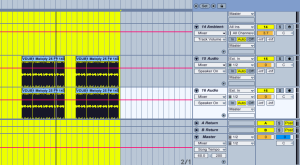Are your synths coming out flat no matter how wide you push them or how well you saturate them? Or perhaps you struggle to get your claps to sound as full as the pros. Electronic music producers commonly face these kinds of issues and it can be exceptionally frustrating when your hard work doesn’t sound the way you want. The answer is often a matter of a layering.
 The What:
The What:
At its core, layering is actually quite simple. It involves taking one sound and placing it on top of another to access a richer combination of sounds and fill up a greater spectrum in the frequency range. In practice, layering is a little more complicated because it involves quite a bit of trial and error with different sounds, the EQ, and other audio effects.
At first this will require some patience as you figure out what sounds mix well and which ones are unpleasant. But over time you’ll learn where certain sounds sit on the frequency spectrum and what extra sounds will help to fill them out and add richness and fullness.
The How:
The first step to layering is to understand where your current sound sits. Pull out an equalizer and see where the heart of your sound is primarily peaking. Then use your equalizer to highlight the important range and turn down the less important parts. In other words, you don’t want to make one sound shoulder the responsibility for the entire frequency range. Give sounds a chance to collaborate with each other and you’ll be surprised by the results.
Sometimes this can be as simple as trimming off the lowest frequencies in a bass synth and tacking on a separate sub bass to provide that lower warmth. Other times you may want to add a different type of sound on top of your first one to give it more complexity and richness. You can even duplicate the same sound a couple of different times — called stacking — and change certain parameters on each one to make things more interesting for your listener.
What’s Next:
Once you have different layers that focus on different frequencies in the same sound, you have much more flexibility to boost something here and reduce something there. You can add huge reverb and width to the top end of a synth but keep the low end nice and centered. You can give your clap a solid crack in the low to middle frequencies and still have an interesting high end decay. Perhaps most importantly, you can mix different sounds together to get a unique timbre that nobody else has used before.
Layering is certainly not something to be restricted to synths alone. Vocals, drums, and pretty much any other type of sound can benefit from this layering technique. The magic of EQing requires a whole other blog post, but these are the basics. Stay tuned to learn more!